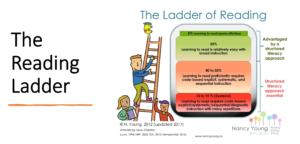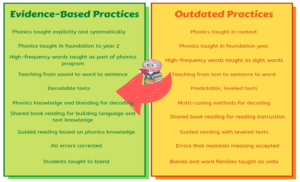
What is Structured Literacy?
Structured Literacy (SL) refers to a method of teaching reading and writing that has been extensively supported by evidence from high quality research. It has been especially helpful for students who struggle with reading by preparing them to decode and encode in an explicit and systematic manner. This approach not only supports students with dyslexia but is highly effective for all readers.
Structured Literacy is an approach where all elements work together, maximising success and reducing confusion about the relationship between phonemes and graphemes (Alphabetic Principle).
Structured Literacy instruction in reading addresses the ‘Big Six’ keys of leaning to read. These components are:
- Oral language
- Phonological awareness
- Structured Synthetic Phonics (Letter-sound knowledge)
- Vocabulary
- Fluency, and
- Comprehension.
The key characteristics or features of successful Structured Literacy instruction include:
- Explicit, systematic, and sequential teaching of literacy at multiple levels.
- Cumulative practice and ongoing opportunity to review and consolidate new learning,
- The use of carefully selected examples and non-examples,
- The use of decodable texts to practice reading and application of skills,
- A high level of student – teacher interaction with prompt corrective feedback,
- Is monitored in a diagnostic, responsive way, which informs the next steps in planning, teaching and intervention to ensure all children develop literacy proficiency.
Explicit Instruction means that the teacher clearly explains, models and guides practice of all concepts and skills. Students are given ample opportunity to apply their developing skills in reading texts they are capable of decoding and comprehending. Review and practice are given with guidance, until they can independently apply newly acquired skills (gradual release of instruction).
Children are not expected to develop these skills based mainly on exposure and incidental learning opportunities.
Teachers provide clear learning intentions and success criteria. Feedback is targeted and individualised in response to each student’s errors, emphasising attention to the print and application of decoding skills.
Systematic. Sequential and Cumulative means that the teacher teaches language concepts systematically and explains how each element fits into the whole. Instruction follows a planned scope and sequence of skills that methodically progresses from easier to more difficult. One concept builds upon another with important prerequisite skills taught before more advanced skills. Care is taken not to introduce skills in a way that is unintentionally confusing. For example, students are not expected to decode or spell complex words before they have learnt to decode and spell simpler words. Teachers avoid introducing highly confusable phonic elements such as b and p, or multiple short vowel sounds simultaneously.
The goal of systematic and sequential teaching is automatic and fluent application of language knowledge to reading and meaning.
Responsive and diagnostic
The teacher tracks progress through activities and classroom practice, adjusting pacing, presentation, and practice as required. There is also continuous formal screening and assessment (for example, standardised measures/ universal screeners). All content is mastered to a degree of automaticity which is critical to free the student’s cognitive load so that they can direct their focus upon comprehension, fluency and expression.
Engaging and multimodal
Structured Literacy is consistent with the application of the Science of Reading (SOR) in the classroom but extends to other important aspects of literacy such as writing. Research has shown that reading and writing have a symbiotic relationship. Both support each other’s development and enhance the consolidation of the skills taught.
Listening, speaking, reading and writing are often paired with one another to foster multimodal language and learning. A range of activities are used to ensure students have the opportunity to practice the skills they are learning.
Structured Literacy instruction in writing is explicitly taught and addresses the components of:
- Understanding text structure and language features,
- Sentence-level grammar,
- Punctuation,
- Tiered vocabulary instruction
- Spelling – morphology and etymology.
Structured Literacy throughout the early years and beyond ensures all children, particularly those most at-risk of literacy difficulties, receive the high-quality literacy instruction they need for reading, writing and ongoing academic success. It ensures that all students can read, create and engage with rich, grade level and increasingly complex texts, as they move through to the upper primary years
and are well positioned for successful learning in secondary schooling.
Why is a structured approach to literacy important?
Nacy Young’s Ladder of Reading (2023) illustrates the impact of structured literacy on all students.
- 5% of students learn effortlessly
- 35% learn relatively easily with broad instruction regardless of quality
- 40- 50% learning to read proficiently requires code based, explicit, systematic and sequential instruction (Tier 1)
- 10-15% (Dyslexia) learning to read requires code based, explicit, systematic and sequential, diagnostic instruction with many repetitions (Tier 2 / Tier 3)
- 5% may have a cognitive deficit.
It is thought that up to 15-20% of the population have signs of dyslexia.
Other reading approaches (e.g., Guided Reading or Balanced Literacy) are not effective for students with dyslexia because these approaches do not focus on the decoding skills struggling readers need to succeed.
Please refer to the follow link if you would like to learn more about this work. The Ladder of Reading & Writing – Dr. Nancy Young, Ed.D.
(IDA website infographic: http:/dyslexiaida.org/what-is-structured-literacy/) What Is Structured Literacy? – International Dyslexia Association
Literacy How Reading Wheel – Literacy How
How Structured Literacy Differs from Outdated Practices.

Further resources for your reference
Student learning support The Literacy Hub (Victoria)
What Is Structured Literacy? – International Dyslexia Association
Structured Literacy Supports All Learners: Students At-Risk of Literacy Acquisition – Dyslexia and English Learners Jennifer S. Ray, Ph.D. Round Rock ISD
The 3 Principles of Structured Literacy Instruction | Lexia
Structured Literacy | Lifting Literacy (Tasmanian Ed Dept)
Further Reading for your Reference
EAB (2019). The Science of Reading Implementation Guide, https://eab.com/research/district-leadership/toolkit/the-science-of-reading-implementation-guide/
Moats, L., 2019. Of ‘Hard Words’ and Straw Men: Let’s Understand What Reading Science is Really About (https://www.voyagersopris.com/blog/edview360/2019/10/16/lets-understand-what-reading-science-is-really-about)
The Reading League, (2020) Curriculum Evaluation Tool https://www.thereadingleague.org/wp-content/uploads/2020/08/Curriculum-Evaluation-Tool-August-2020.pdf
Riley, B., 2020. Drawing on Reading Science without Starting a War. Educational Leadership, 77(5), pp.16-22. (http://www.ascd.org/publications/educational-leadership/feb20/vol77/num05/Drawing-on-Reading-Science-Without-Starting-a-War.aspx)
Scarborough, H. S. (2001). Connecting early language and literacy to later reading (dis)abilities: Evidence, theory, and practice. In S. Neuman & D. Dickinson (Eds.), Handbook for research in early literacy (pp. 97–110). New York, NY: Guilford Press. (https://www.guilford.com/books/Handbook-of-Early-Literacy-Research-Volume-1/Neuman-Dickinson/9781572308954/contents)
The Science of Reading: A new Era of reading Instruction https://www.zaner-bloser.com/reading/superkids-reading-program/pdfs/Whitepaper_TheScienceofReading.pdf
Westerveld, M.F., Armstrong, R.M. and Barton, G.M., 2020. Reading Success in the Primary Years: An Evidence-Based Interdisciplinary Approach to Guide Assessment and Intervention. (https://www.springer.com/gp/book/9789811534911)
Moats, L.C., 1999. Teaching reading is rocket science: What expert teachers of reading should know and be able to do. https://www.aft.org/sites/default/files/moats.pdf
Breaking the Code, https://www.breakingthecode.com/10-reasons-three-cueing-ineffective/
Hempenstall, K.E.R.R.Y., 2002. The Three-Cueing System: Help or Hindrance? Direct Instruction News, 2(2), pp.42-51. https://lizditz.typepad.com/files/din_02_02_10-1.pdf
Ehri, L.C., 2014. Orthographic mapping in the acquisition of sight word reading, spelling memory, and vocabulary learning. Scientific Studies of Reading, 18(1), pp.5-21. https://www.tandfonline.com/doi/abs/10.1080/10888438.2013.819356
Source of the Active View of Reading Graphic: Duke, N. K., & Cartwright, K. B. (2021). The science of reading progresses: Communicating advances beyond the Simple View of Reading. Reading Research Quarterly, 56(S1), S25-S44. https://ila.onlinelibrary.wiley.com/doi/full/10.1002/rrq.411
This is an open access article under the terms of the Creative Commons Attribution-NonCommercial-NoDerivs License, which permits use and distribution in any medium, provided the original work is properly cited, the use is non-commercial and no modifications or adaptations are made.
